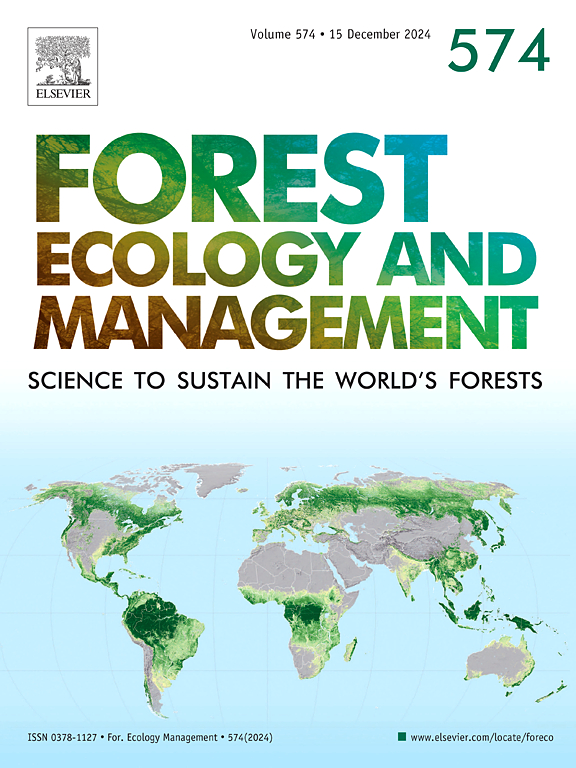Canopy cover and forest management shape vertebrate scavenger assembly but not carrion removal rates
IF 3.7
2区 农林科学
Q1 FORESTRY
引用次数: 0
Abstract
Carrion decomposition is a key process in nutrient cycling and ecosystem functioning, driven by microorganisms, necrophagous insects, and vertebrate scavengers. The rate of decomposition is influenced by various factors, including environmental conditions, carcass characteristics, and scavenger assembly. In forests, canopy cover and structure shape microclimatic conditions and habitat features, yet little is known about how these characteristics affect carrion decomposition by vertebrate scavengers. As forest disturbances increasingly open up canopies, understanding the impact of canopy cover on carrion decomposition becomes essential. We investigated removal rates of small carrion at paired gap and closed-forest plots along a gradient of forest-management intensity in three regions in Germany, using camera traps to monitor vertebrate scavengers. Of 89 rat carcasses, 67 were removed by vertebrates. Initial removal rates were higher in gaps than in closed forests and at plots with higher forest-management intensity. However, over the full exposure time, removal rates were similar across all treatments. Differences in temporal patterns of carrion removal were linked to shifts in scavenger dominance, with red kite (Milvus milvus) prevalent in gaps and red fox (Vulpes vulpes) in closed forest. Our findings indicate that forest management and changes in canopy cover, such as those caused by disturbances, have little impact on carrion removal rates. Vertebrate scavenger assembly however differed between open and closed forests, which suggests functional redundancy among scavengers but that it is important that carrion resources are available for scavengers both in gaps and closed forests to promote overall biodiversity and maintain their ecosystem functions.
林冠覆盖和森林管理决定了脊椎动物的腐肉清除率,而不是腐肉清除率
腐肉分解是营养循环和生态系统功能的关键过程,由微生物、尸食性昆虫和脊椎动物食腐动物驱动。分解速度受到各种因素的影响,包括环境条件、胴体特性和清道夫组件。在森林中,林冠覆盖度和结构塑造了小气候条件和栖息地特征,但这些特征如何影响脊椎动物腐肉分解却知之甚少。随着森林扰动越来越多地打开冠层,了解冠层覆盖对腐肉分解的影响变得至关重要。在德国的三个地区,利用相机陷阱监测脊椎动物食腐动物,沿着森林管理强度的梯度,研究了成对的林隙和封闭森林样地的小腐肉清除率。89具大鼠尸体中,67具被脊椎动物取出。林隙的初始砍伐率高于封闭林和森林管理强度较高的样地。然而,在整个暴露时间内,所有处理的去除率相似。腐肉清除的时间模式的差异与食腐动物优势的变化有关,红鸢(Milvus Milvus)普遍存在于间隙中,红狐(Vulpes Vulpes)普遍存在于封闭森林中。我们的研究结果表明,森林管理和林冠覆盖的变化(如干扰引起的变化)对腐肉清除率的影响很小。然而,在开放和封闭森林中,脊椎动物的食腐动物组合存在差异,这表明食腐动物之间存在功能冗余,但重要的是,在林隙和封闭森林中,食腐动物都能获得腐肉资源,以促进整体生物多样性和维持其生态系统功能。
本文章由计算机程序翻译,如有差异,请以英文原文为准。
求助全文
约1分钟内获得全文
求助全文
来源期刊

Forest Ecology and Management
农林科学-林学
CiteScore
7.50
自引率
10.80%
发文量
665
审稿时长
39 days
期刊介绍:
Forest Ecology and Management publishes scientific articles linking forest ecology with forest management, focusing on the application of biological, ecological and social knowledge to the management and conservation of plantations and natural forests. The scope of the journal includes all forest ecosystems of the world.
A peer-review process ensures the quality and international interest of the manuscripts accepted for publication. The journal encourages communication between scientists in disparate fields who share a common interest in ecology and forest management, bridging the gap between research workers and forest managers.
We encourage submission of papers that will have the strongest interest and value to the Journal''s international readership. Some key features of papers with strong interest include:
1. Clear connections between the ecology and management of forests;
2. Novel ideas or approaches to important challenges in forest ecology and management;
3. Studies that address a population of interest beyond the scale of single research sites, Three key points in the design of forest experiments, Forest Ecology and Management 255 (2008) 2022-2023);
4. Review Articles on timely, important topics. Authors are welcome to contact one of the editors to discuss the suitability of a potential review manuscript.
The Journal encourages proposals for special issues examining important areas of forest ecology and management. Potential guest editors should contact any of the Editors to begin discussions about topics, potential papers, and other details.
 求助内容:
求助内容: 应助结果提醒方式:
应助结果提醒方式:


